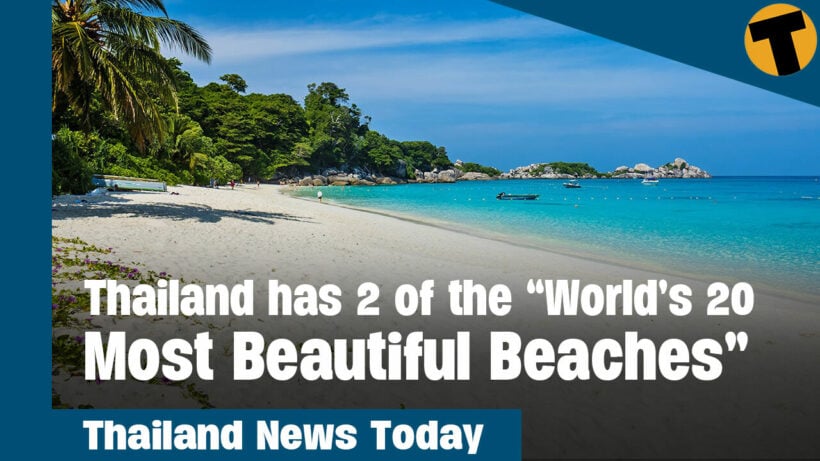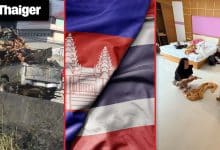Thailand News Today | Thailand has 2 of the “World’s 20 Most Beautiful Beaches”

In a new list published in UK’s Daily Star newspaper, Thailand has two of the “World’s 20 Most Beautiful Beaches”
Thailand’s Sunrise Beach was ranked in sixth place, and Maya Bay came in at 12th place on the list.
Sunrise Beach is reportedly the most popular beach on Koh Lipe island, with longtail boats gliding across its waters where smaller islands can be seen across the beach.
Maya Bay, the other Thai beach on the list, was made famous when it became the setting for the movie “The Beach” starring Leonardo DiCaprio. It has a number of plant and animal species, most famously blacktip sharks. Maya Bay, located in Krabi will temporarily close for environmental restoration between August 1 and September 30. This way, such species can stay abundant.
California’s Venice Beach led the pack in the first place, followed by Main Beach in Byron Bay, Australia. Other countries with top-rated beaches include Venezuela, Vietnam, New Zealand, and Sri Lanka, among others.
The list, published on July 21, was created through an analysis of Instagram post data, and the number of Google articles containing the word ‘beautiful’. The number of searches for “what are the most beautiful beaches” has increased this year by 220%.
—————–
Fears Thailand is in the process of deporting asylum-seeking Uyghurs back to China have been denied by the government.
News broke yesterday that dozens of Uyghurs from all around Thailand had been rounded up and impounded in a detention facility in Bangkok.
It sparked a sharp response from Thailand’s Islamic council, and seven local NGOs, who released a joint statement questioning the Uyghur detainees’ transfer to Bangkok.
“This action raised concerns among the civil society network monitoring the Uyghur situation that the Thai government will force the Uyghurs to return to their country of origin at the request of the Chinese government.”
The People’s Empowerment Foundation says their sources told them that Uyghurs were brought from different detention centres across the country and are now all held together at the Suan Plu Immigration Detention Centre.
56 Uyghurs have been left in limbo in Thailand after entering the country illegally while fleeing from Xinjiang Uyghur Autonomous Region in Northwest China in 2014.
The NGOs believe the Uyghurs are being held in detention centres because Thailand is under pressure to send them back to China. But Thailand denies this, with the Prime Minister’s office saying that they were moved to a detention centre in Bangkok for safety reasons. The office refused to answer whether the Thai government would send the Uyghurs back to China.
The NGOs, and the Muslim council, also told the government to be mindful of an incident in 2015 when it deported 109 Uyghurs to China. The fates of those are still unknown.
The Uyghur people are a Muslim minority who have endured repression by the Chinese government for a number of years after several terrorist attacks on the mainland were carried out by extremists. The last of which was believed to be in 2017.
—————–
Thailand’s Public Ministry, who so eagerly rushed to decriminalise the happy plant but is now managing the legislative trainwreck that ensued, has requested a widespread crackdown of the plant, then later retracted this request.
First, it’s very illegal with harsh punishments, then suddenly it’s legal with no restrictions, then it’s banned by the government, military, children, and pregnant women, then they said it was never intended for recreational use, and then cigarettes containing it will be banned. Now the rollercoaster that is the decriminalisation of the plant, whose name Youtube will flag us if we say it, took another sharp u-turn as the Ministry of Public Health asked police to take swift legal action against unlicensed dealers and then immediately backed down after an equally swift backlash.
Deputy Permanent Secretary for Public Health Dr. Narong said that the ministry would revise its proposal after realising, after the fact, that the letter they wrote to the police will harm so many households and vendors. The regretful letter demanded a crackdown against sellers, processors, exporters, and researchers of the plant while the lack of regulations has created an unclarity that would negatively affect so many people.
They have now withdrawn the letter saying that targeting needs to be more specific. Instead, they now say that legislation allows for people to use leaves, stems, branches, and roots, and any legal action should target only people who make use of the flowers themselves. Let’s see how many hours it takes to retract this new statement.
That’s because even the flowers exist in somewhat of a grey area, as the Department of Thai Traditional and Alternative Medicine has now suggested that instead of the Ministry of Public Health Banning them, they should set a legal limit for how many flowers a household can have so as to allow people to use them for personal health remedies.
For now, though, the ministry has rescinded its call for arrest and prosecution and will revisit the plans and regulations and make more conclusive decisions next week.
—————
At the Thaiger, we’ve presented stories arguing both sides of the issue. This time, we’re reporting on two new studies that suggest that Covid-19 seems to have originated from a wet market in Wuhan, not from a lab leak.
The studies were published Tuesday in the academic journal Science. One study looked at December 2019, and the geographic spread of the first Covid cases, finding that they centred very closely around the Huanan Market. The second study approached the pandemic from the biological side, finding that tracing the evolution of the virus from genomic data in the earliest cases suggests that widespread human infections before November of 2019 are very unlikely.
The two studies had been shared in their early stages, but have now gone through scientific peer-review to be published in a reputable academic journal. Co-author Kristian Anderson of The Scripps Research Institute said that, while no research can definitively disprove lab leak theories, it shows that a natural animal to human spread of coronavirus is far more plausible.
He said, quote, “I think what’s really important here is that there are possible scenarios, and there are plausible scenarios, and it’s really important to understand that possible does not mean equally likely.”
Notably, a co-author of both of the papers, the University of Arizona’s Michael Worobey, had embarked on his study by encouraging the scientific community to consider more seriously the possibility of a lab leak being the coronavirus source. But upon completion of the studies, data pointed to the viral outbreak starting from the Wuhan market and the trading of wildlife, without any sinister or malicious origin.
While the animal market in Wuhan has long been studied, some felt that it merely amplified the already existing lab-sourced outbreak, but pinpointing studies at a neighbourhood level suggest that it most likely jumped from animals to humans. Hog Badgers, raccoon dogs, and red foxes that are known to be able to carry Covid were all available for sale in the market, where 155 of the first 174 infections were located.
The first study found that the early cases centred around the market, and then people were exposed by living near the market. Researchers were able to de-randomise the early spread from there by deep-diving into the Chinese Weibo social media app and people’s check-ins online.
The second study found an interesting scenario where two early strains of Covid began spreading around the market at the same time.
This suggests that in November and December of 2019, Covid jumped on multiple occasions from animals to humans in that Wuhan Market, forming the true origin story of the virus that evolved into the massive global pandemic we all know today.
Latest Thailand News
Follow The Thaiger on Google News:


























